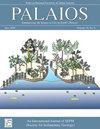东南大西洋热带雨林现代高地的蕨类植物相互作用揭示了节肢动物对化石-植物-昆虫相互作用的损害
IF 1.5
4区 地球科学
Q2 GEOLOGY
引用次数: 2
摘要
摘要蕨类植物是化石记录中最早出现的阔叶植物之一。我们评估了现代蕨类植物中蕨类-节肢动物的相互作用,作为与化石记录中蕨类植物损伤比较的模型。研究发现,在海拔750 ~ 900米的巴西大西洋热带雨林山坡上,13种蕨类植物存在边缘摄食、孔摄食、地表摄食、刺吸、产卵、采食和刺食等功能摄食类群。我们识别了17种损伤类型(DT),其中包括一种新的DT,并为解释化石记录中的叶片损伤提供了启示。在蕨类植物中发现了9个具有现代类似物的化石。对现代蕨类植物的损害评价表明,外部取食、刺吸、磨蚀和采掘的丰度和损害特征的变化增强了对化石叶片损害模式的理解。基于现代节肢动物损伤的取样和蕨类植物的保存偏差,提供了植物-昆虫化石相互作用的地语学意义。在植物化石记录中,与蕨类植物附着较差的节肢动物遗骸,如蜘蛛网、卵、蜘蛛卵囊,以及昆虫的蜕液、蛹和身体部位,可能为与蕨类植物叶子相关的节肢动物保存提供了一个重要特征。这种综合方法表明,现代蕨类植物的DT特征表明蕨类植物是食草节肢动物的重要寄主植物。因此,蕨类植物作为节肢食草动物寄主植物的重要性可能在很久以前就存在。本文章由计算机程序翻译,如有差异,请以英文原文为准。
FERN-ARTHROPOD INTERACTIONS FROM THE MODERN UPLAND SOUTHEAST ATLANTIC RAINFOREST REVEALS ARTHROPOD DAMAGE INSIGHTS TO FOSSIL PLANT-INSECT INTERACTIONS
Abstract: Ferns were among the first broadleaved plants in the fossil record. We assessed fern-arthropod interactions in modern ferns (Monilophyta) as a model for comparison with damage on ferns in the fossil record. We found that the functional feeding groups of margin feeding, hole feeding, surface feeding, piercing and sucking, oviposition, mining, and galling was present on 13 species of ferns at elevations ranging from 750 to 900 meters along mountain slopes of the Brazilian Atlantic Rainforest. We recognized 17 damage types (DTs), including one new DT, and provide implications for interpreting damage on leaves in the fossil record. Nine fossil DTs with modern analogues were found on ferns. Evaluation of damage on modern ferns demonstrate that the variation in the abundance and damage signatures of external feeding, piercing and sucking, galling, and mining enhances understanding of damage patterns on fossil leaves. The taphonomic implications to fossil plant-insect interactions are provided based on the sampling of modern arthropod damage and the preservation biases on ferns. Arthropod remains that are poorly attached to ferns, such as silk webs, eggs, and spider egg sacs, as well as insect exuviae, pupae, and body parts, might provide an important feature for arthropod preservation associated with fern leaves in the plant fossil record. This integrative method demonstrates that DT signatures on modern ferns indicate that ferns are an important host plant for herbivorous arthropods. Consequently, the same importance of ferns as host plants of arthropod herbivores likely was present in deep time.
求助全文
通过发布文献求助,成功后即可免费获取论文全文。
去求助
来源期刊

Palaios
地学-地质学
CiteScore
2.80
自引率
12.50%
发文量
40
审稿时长
6 months
期刊介绍:
PALAIOS is a monthly journal, founded in 1986, dedicated to emphasizing the impact of life on Earth''s history as recorded in the paleontological and sedimentological records. PALAIOS disseminates information to an international spectrum of geologists and biologists interested in a broad range of topics, including, but not limited to, biogeochemistry, ichnology, paleoclimatology, paleoecology, paleoceanography, sedimentology, stratigraphy, geomicrobiology, paleobiogeochemistry, and astrobiology.
PALAIOS publishes original papers that emphasize using paleontology to answer important geological and biological questions that further our understanding of Earth history. Accordingly, manuscripts whose subject matter and conclusions have broader geologic implications are much more likely to be selected for publication. Given that the purpose of PALAIOS is to generate enthusiasm for paleontology among a broad spectrum of readers, the editors request the following: titles that generate immediate interest; abstracts that emphasize important conclusions; illustrations of professional caliber used in place of words; and lively, yet scholarly, text.
 求助内容:
求助内容: 应助结果提醒方式:
应助结果提醒方式:


